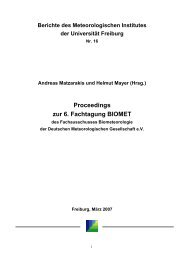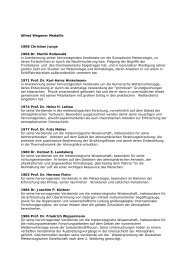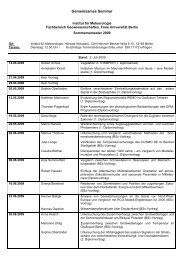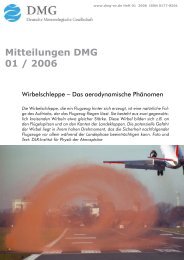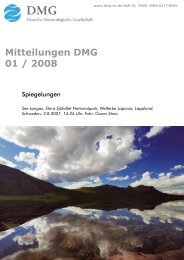Mitteilungen DMG 02 / 2008 - Deutsche Meteorologische ...
Mitteilungen DMG 02 / 2008 - Deutsche Meteorologische ...
Mitteilungen DMG 02 / 2008 - Deutsche Meteorologische ...
Erfolgreiche ePaper selbst erstellen
Machen Sie aus Ihren PDF Publikationen ein blätterbares Flipbook mit unserer einzigartigen Google optimierten e-Paper Software.
2.2.5 Precipitation<br />
The MOMAA station network also provides information<br />
about precipitation. They are equipped with<br />
YOUNG tipping bucket rain gauges with a resolution<br />
of 0.2 mm per tip. In addition, 5 of 10 rain gauges can<br />
be heated which makes it possible to measure solid precipitation.<br />
www.youngusa.com<br />
2.3 Data Logger<br />
All MOMAA stations are equipped with CR1000 data<br />
loggers from Campbell Scientific. They work like a<br />
computer which collect the sensor data, process them<br />
if necessary and store them in the required file format.<br />
Data can be downloaded via the serial port or via a digital<br />
GSM modem. www.campbellsci.com<br />
2.4 Other instruments<br />
Besides the MOMAA automatic weather station, IMGI<br />
contributed additional instruments to COPS.<br />
• Six DAVIS rain gauges which were set up in<br />
vicinity to some NCAS AWSs as they were not<br />
equipped for precipitation measurement<br />
• One OTT PLUVIO weighing rain gauge at site<br />
Besenfeld; www.ott-hydrometrie.de<br />
• Two Disdrometers from THIESclima at sites<br />
Hornisgrinde and Besenfeld www.thiesclima.de<br />
3 MOMAA Network at COPS<br />
3.1 Pre-field phase comparison<br />
As the stations had only been purchased recently, we<br />
did not have much experience in using them in the field.<br />
In order to test the stations beforehand and to get an<br />
overview about their working character and difference<br />
in data recording, the stations were set up on the roof of<br />
the IMGI. Preliminary quick looks were produced for<br />
the detection of possible technical problems.<br />
3.2 Field phase<br />
As one of the major interests lies in the better understanding<br />
of thermally-driven orographic flows on slo-<br />
studenten<br />
Fig. 2: Setup of MOMAA station sensors prior to field phase (left); the joy of meteorological field work in the Black Forest (right).<br />
pes and along valleys the combined station network of<br />
IMGI and NCAS had to be set up accordingly. Roughly<br />
speaking, the NCAS covered the western slopes of the<br />
northern Black Forest between Achern and Bühl and<br />
the Murg valley, while the MOMAA stations were set<br />
up along the Enz valley and at various hilltops and plateaus<br />
along these two valleys. The data was collected<br />
manually on a weekly basis. It was considered to do<br />
it via GSM transmission but as the GSM network coverage<br />
was very weak throughout the Black Forest, we<br />
had to download the data directly from the stations.<br />
The stations were operational from the end of week<br />
26 until the end of week 31. Fortunately, the worst problems<br />
we encountered throughout the whole measurement<br />
period were bird droppings and insects in the rain<br />
gauge.<br />
3.3 Post-field phase comparison<br />
After we had returned from COPS, the stations were set<br />
up again in the IMGI weather garden for further testing.<br />
One important test was a comparison of the rain gauges<br />
by using medical drips with a certain amount of water.<br />
There the stations remained installed until the end<br />
of September. Quicklooks of this second comparison<br />
measurements should be available from the beginning<br />
of October.<br />
3.4 Post-field data processing<br />
Now that COPS is over and we have all the MOMAA<br />
station data on our IMGI data base there is still a lot of<br />
work to do until the data can be uploaded to the `World<br />
Data Center for Climate‘ (WDCC).<br />
• It will have to be decide which parameters will be<br />
put in the final data files<br />
• Quality control of the data: detection of outliers<br />
and questionable data<br />
• Create a continuous time series of data by eliminating<br />
double times and by filling up missing<br />
times with error flags<br />
• Converting output files to netCDF format<br />
<strong>Mitteilungen</strong> <strong>02</strong>/<strong>2008</strong><br />
19



